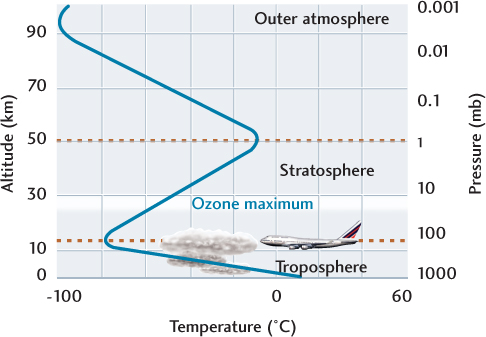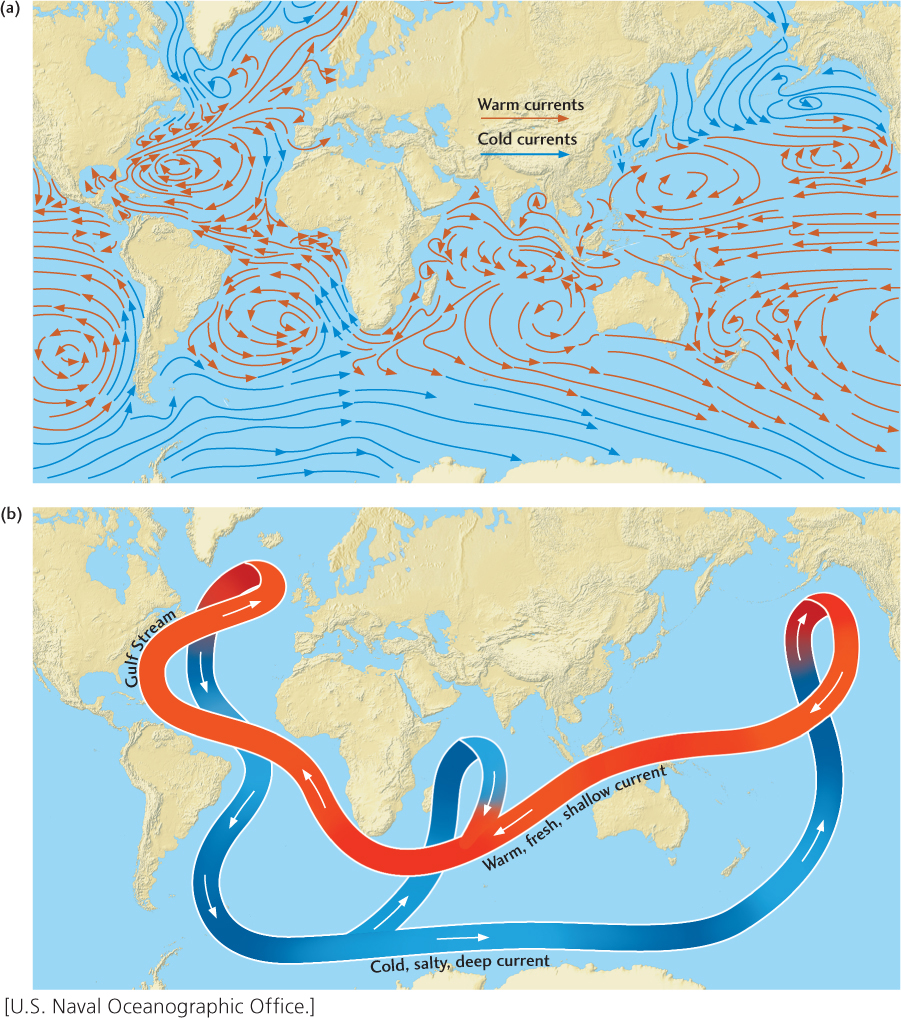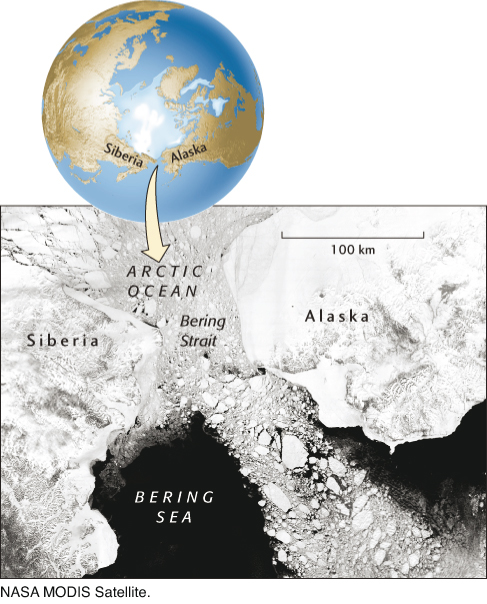Components of the Climate System
At any point on Earth’s surface, the amount of energy received from the Sun changes on daily, yearly, and longer-term cycles associated with Earth’s movement through the solar system. This cyclical variation in the input of solar energy, known as solar forcing, causes changes in the surface environment: temperatures rise during the day and fall at night, and they rise in summer and fall in winter. The term climate refers to the average conditions at a point on Earth’s surface and their variation during these cycles of solar forcing.
Climate is described by daily and seasonal statistics on the atmospheric temperature near Earth’s surface (the surface temperature) as well as surface humidity, cloud cover, rate of rainfall, wind speed, and other weather conditions. Table 15.1 gives an example of seasonal temperature statistics for New York City, which include measures of temperature variation (record highs and lows) as well as average values. In addition to these common weather statistics, a full scientific description of climate includes the nonatmospheric components of the surface environment, such as soil moisture and streamflow on land as well as sea surface temperature and the velocity of currents in the oceans.
| Data Type* | January 1 | April 1 | July 1 | October 1 |
|---|---|---|---|---|
| Record high | 62 | 83 | 100 | 88 |
| Average high | 39 | 56 | 82 | 69 |
| Average low | 28 | 39 | 67 | 55 |
| Record low | −4 | 12 | 52 | 36 |
| * Temperatures are averages for the date shown for the 30-year period 1971–2000; record temperatures are those for the period 1869–2011. | ||||
The climate system includes all the components of the Earth system and all the interactions among those components that determine how climate varies in space and time (Figure 15.1). The main components of the climate system are the atmosphere, hydrosphere, cryosphere, lithosphere, and biosphere. Each component plays a different role in the climate system, and that role depends on its ability to store and transport mass and energy.

The Atmosphere
Earth’s atmosphere is the most mobile and rapidly changing part of the climate system. Like Earth’s interior, the atmosphere is layered (Figure 15.2). About three-fourths of its mass is concentrated in the layer closest to Earth’s surface, the troposphere, which has an average thickness of 11 km. Above the troposphere is the stratosphere, a dryer layer that extends to an altitude of about 50 km. The outer atmosphere, above the stratosphere, has no abrupt cutoff; it slowly becomes thinner and fades away into outer space.

The troposphere convects vigorously due to the uneven heating of Earth’s surface by the Sun (tropos is the Greek word for “turn” or “mix”). When air is warmed, it expands, becomes less dense than cooler air, and tends to rise; conversely, cool air tends to sink. The resulting convection patterns in the troposphere (which we’ll examine more closely in Chapter 19), combined with Earth’s rotation, set up a series of prevailing wind belts. In temperate regions, the prevailing winds have a generally eastward flow, such that they transport a typical parcel of air eastward around the globe in about a month (which is why it takes a few days for storms to blow across the continental United States). The spiral-like global circulation of air in these wind belts also transports heat energy from the warmer equatorial regions to the cooler polar regions.
409
The atmosphere is a mixture of gases, mainly nitrogen (78 percent by volume in dry air) and oxygen (21 percent by volume). The remaining 1 percent consists of argon (0.93 percent), carbon dioxide (0.035 percent), and other minor gases (0.035 percent), including methane and ozone. Water vapor is concentrated in the troposphere in highly variable amounts (up to 3 percent, but typically about 1 percent). Water vapor and carbon dioxide are the principal greenhouse gases in the atmosphere.
Ozone (O3+) is a highly reactive greenhouse gas produced primarily by the ionization of molecular oxygen by ultraviolet radiation from the Sun. In the lower part of the atmosphere, ozone exists in only tiny amounts, although it is a strong enough greenhouse gas to play a significant role in regulating Earth’s surface temperature. Most atmospheric ozone is found in the stratosphere, where its concentration reaches a maximum at an altitude of 25 to 30 km (see Figure 15.2). This stratospheric ozone layer filters out incoming ultraviolet radiation, protecting the biosphere at Earth’s surface from its potentially damaging effects.
The Hydrosphere
The hydrosphere comprises all the liquid water on, over, and under Earth’s surface, including oceans, lakes, streams, and groundwater. Almost all of that liquid water is in the oceans (1350 million cubic kilometers); lakes, streams, and groundwater constitute a mere 1 percent (15 million cubic kilometers) of the hydrosphere. However small, these continental components of the hydrosphere play a vital role in the climate system. They are reservoirs for moisture on land and provide the transport system for returning precipitation and transporting salt and other minerals to the oceans.
410
Although water circulates more slowly in the oceans than air does in the atmosphere, water can store much more heat energy than air. For that reason, ocean currents transport heat energy very effectively. Prevailing winds blowing across the oceans generate surface currents, which give rise to large-scale circulation patterns within ocean basins (Figure 15.3a).

Oceanic circulation patterns involve vertical convection as well as horizontal movement. The Gulf Stream, for example, flows from the Caribbean Sea and the Gulf of Mexico along the western Atlantic margin, carrying warm water that warms the climate of the North Atlantic and Europe. In the North Atlantic, that water cools and becomes more saline (because less fresh water enters the oceans from rivers at high latitudes than evaporates from the ocean surface). Cool water is denser than warm water, and salty water is denser than fresh water; therefore, this cooler, saltier water sinks. In this way, a subsurface cold current is created that flows southward as part of a global pattern of thermohaline circulation—so called because it is driven by differences in temperature and salinity. On a global scale, thermohaline circulation acts like an enormous conveyor belt running through the oceans that moves heat from the equatorial regions toward the poles (Figure 15.3b). Changes in this circulation pattern can strongly influence global climate.
411
The Cryosphere
The ice component of the climate system is called the cryosphere. It comprises 33 million cubic kilometers of ice, primarily in the ice caps of the polar regions. Today, continental glaciers cover about 10 percent of the land surface (15 million square kilometers), storing about 75 percent of the world’s fresh water. Floating ice includes sea ice in the open ocean, as well as frozen lake and river water. The role of the cryosphere in the climate system differs from that of the liquid hydrosphere because ice is relatively immobile and because it reflects almost all of the solar energy that falls on it.
The seasonal exchange of water between the cryosphere and the hydrosphere is an important process of the climate system. During winter, sea ice typically covers 14 million to 16 million square kilometers of the Arctic Ocean (Figure 15.4) and 17 million to 20 million square kilometers of the Southern Ocean, shrinking to about one-third of that area in summer. About one-third of the land surface is covered by seasonal snows, almost entirely (all but 2 percent) in the Northern Hemisphere. Melting snow is the source of much of the fresh water in the hydrosphere. In the U.S. Sierra Nevada and Rocky Mountains, for example, 60 to 70 percent of annual precipitation is snowfall, which is later released as water during spring snowmelt and stream runoff. Much larger amounts of water are exchanged between the cryosphere and the hydrosphere during glacial cycles. At the peak of the most recent ice age, 20,000 years ago, sea level was about 130 m lower than it is today, and the volume of the cryosphere was three times larger.

The Lithosphere
The part of the lithosphere that is most important to the climate system is the land surface, which makes up about 30 percent of Earth’s total surface area. The composition of the land surface affects the way it absorbs solar energy or releases it to the atmosphere. As the temperature of the land surface rises, more heat energy is radiated back into the atmosphere, and more water evaporates from the land surface and enters the atmosphere. Because evaporation uses considerable energy, it causes the land surface to cool. Consequently, soil moisture and other factors that influence rates of evaporation—such as vegetation cover and the subsurface flow of water—are very important in controlling atmospheric temperatures.
Topography has a direct effect on climate through its influence on atmospheric circulation. Air masses that flow over mountain ranges dump rain on the windward side, creating a rain shadow on the leeward side of the mountains (see Figure 17.3). At much longer time scales, geologists have documented many changes in the climate system that result from plate tectonic processes. The overall asymmetry of the continents—a direct consequence of plate movements—induces hemispheric asymmetries in the global climate system. Changes in the shape of the seafloor due to seafloor spreading cause changes in sea level, and the drift of continents over the poles leads to the growth of continental glaciers. The movements of continents can also block ocean currents or open gateways through which they can flow, inhibiting or facilitating the global transfer of heat. For example, if future tectonic activity were to close the narrow channel between the Bahamas and Florida through which the Gulf Stream flows, average temperatures in western Europe might drop drastically.
412
Volcanism in the lithosphere affects climate by changing the composition and properties of the atmosphere. As we saw in Chapter 12, large volcanic eruptions can inject aerosols into the stratosphere, blocking solar radiation and temporarily lowering atmospheric temperatures on a global scale. After the massive April 1815 eruption of Mount Tambora in Indonesia, New England suffered through a “year without a summer” in 1816, which caused widespread crop failures. Recent large volcanic eruptions—including those of Krakatau (1883), El Chichón (1982), and Mount Pinatubo (1991)—each produced an average dip of 0.3°C in global surface temperatures about 14 months after the eruption. Temperatures returned to normal in about 4 years.
The Biosphere
The biosphere comprises all the organisms living on and beneath Earth’s surface, in its atmosphere, and in its waters. Life is found almost everywhere on Earth, but the amount of life at any location depends on local climate conditions, as we can see from the satellite image of plant and algal biomass in Figure 15.5.

The total energy contained and transported by living organisms is relatively small on a global scale: less than 0.1 percent of incoming solar energy is used by plants in photosynthesis and thus enters the biosphere. The biosphere, however, is strongly coupled to the other components of the climate system by the metabolic processes described in Chapter 11. For example, terrestrial vegetation can affect atmospheric temperature, because plants absorb solar radiation for photosynthesis and release it as heat during respiration, and atmospheric moisture, because they take up groundwater and release it as water vapor. Organisms also regulate the composition of the atmosphere by taking up or releasing greenhouse gases such as carbon dioxide (CO2) and methane (CH4). Through photosynthesis, plants and algae transfer CO2 from the atmosphere to the biosphere. Some of the carbon from that CO2 moves from the biosphere to the lithosphere when it is precipitated as calcium carbonate shells or buried as organic matter in marine sediments. The biosphere thus plays a central role in the carbon cycle.
Humans, of course, are part of the biosphere, though hardly an ordinary part. Our influence over the biosphere is growing rapidly, and we have become the most active agents of environmental change. As an organized society, we behave in fundamentally different ways from other species. For example, we can study climate change scientifically and modify our actions according to what we have learned.
One of the anthropogenic changes in the climate system that is of greatest concern is a recent increase in atmospheric concentrations of greenhouse gases. We’ll look next at the factors that regulate Earth’s surface temperature and at the role greenhouse gases play in that process.
413